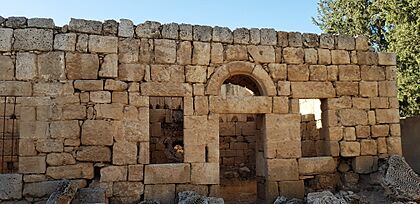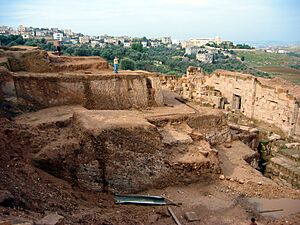Yazid II facts for kids
Quick facts for kids Yazid IIيَزِيد ٱبْن عَبْد الْمَلِك |
|||||
|---|---|---|---|---|---|
|
|||||

Gold dinar of Yazid II
|
|||||
| 9th Caliph of the Umayyad Caliphate | |||||
| Reign | 9 February 720 – 26 January 724 | ||||
| Predecessor | Umar | ||||
| Successor | Hisham | ||||
| Born | c. 690/91 Damascus, Umayyad Caliphate |
||||
| Died | 26 January 724 (aged c. 33–34) (24 Sha'ban 105 AH) Irbid, Umayyad Caliphate |
||||
| Spouse |
|
||||
| Issue |
|
||||
|
|||||
| Dynasty | Umayyad | ||||
| Father | ʿAbd al-Malik | ||||
| Mother | ʿĀtika bint Yazīd | ||||
| Religion | Islam | ||||
Yazid ibn Abd al-Malik ibn Marwan (Arabic: يَزِيد ٱبْن عَبْد الْمَلِك ٱبْن مَرْوَان; c. 690/91 — 26 January 724), known as Yazid II, was the ninth Caliph of the Umayyad Caliphate. He ruled from 720 until his death in 724.
Even though he didn't have much experience in leading armies or managing government, Yazid II was respected because of his family background. He came from both main branches of the Umayyad dynasty. His half-brother, Caliph Sulayman ibn Abd al-Malik, chose him to be the next ruler after their cousin Umar.
Yazid II changed many of the policies that Umar had put in place. For example, he brought back the jizya, which was a tax on non-Arab Muslims. He also restarted military efforts on the borders of the Caliphate. This included fighting against the Khazars in the Caucasus and the Byzantines in Anatolia. These changes were popular with the Arab military leaders and the Umayyad family. However, they didn't solve the Caliphate's money problems. War gains were not enough, and many people in places like Khurasan and Ifriqiya resisted the jizya tax.
Yazid II also issued an order to destroy Christian images, known as iconoclasm. This action may have influenced the Byzantine emperor Leo III to do something similar in his own empire. Yazid II also brought Syrian soldiers back to Iraq to help control the region. One of the first big events of his rule was a large rebellion in Iraq led by Yazid ibn al-Muhallab. Putting down this rebellion ended major anti-Umayyad uprisings in that area.
Contents
Early Life and Family
Yazid II was born in Damascus, the capital city of the Umayyad Caliphate, around 690 or 691. His father was Caliph Abd al-Malik ibn Marwan, and his mother was Atika. Atika was the daughter of Caliph Yazid I, who was Yazid II's namesake. Sometimes, people called him 'Ibn Atika', meaning 'son of Atika'.
Yazid II's family background was very important. It connected him to both the Marwanid branch of the Umayyad family (his father's side) and the Sufyanid branch (his mother's side). The Sufyanids, like Yazid I's father Mu'awiya I, were the first to found the Umayyad Caliphate.
Before becoming caliph, Yazid II did not have much experience leading armies or managing government affairs. He mostly stayed in Syria. He only traveled a few times to the Hejaz (western Arabia), which is where the holy cities of Mecca and Medina are located. One of these trips was for the annual Hajj pilgrimage.
Yazid II may have been given control of the area around Amman by his father. He also built two desert palaces, al-Qastal and al-Muwaqqar, near Amman. While these palaces are usually thought to have been built during his time as caliph, some experts believe he started building them earlier.
Yazid II also formed family ties with the powerful family of al-Hajjaj ibn Yusuf, who was a governor in Iraq. He married al-Hajjaj's niece, Umm al-Hajjaj. She gave birth to two of his sons, al-Hajjaj (who died young) and al-Walid II, who later became caliph. Yazid II also married Su'da bint Abd Allah, who was a great-granddaughter of Caliph Uthman. She was the mother of his children Abd Allah and A'isha.
Becoming Caliph
Because of his important family background, Yazid II was a natural choice to become caliph. Having a noble Arab mother was very important in the Caliphate at this time. Yazid II was proud of his mother's Sufyanid family. He felt he was more important than his half-brothers from his father's side.
His half-brother, Caliph Sulayman ibn Abd al-Malik, chose him to be the second in line to rule after their cousin Umar. Yazid II became caliph at the age of 29 after Umar died on February 9, 720. For most of his rule, he lived in Damascus or on his estates in the Jund al-Urdunn (military district of Jordan).
Major Challenges and Policies
Rebellion in Iraq
Soon after Yazid II became caliph, a military leader named Yazid ibn al-Muhallab escaped from prison. He had been a governor in Iraq and the eastern province of Khurasan. He was an enemy of al-Hajjaj, who was Yazid II's father-in-law. Ibn al-Muhallab worried that Yazid II would punish him.
Ibn al-Muhallab went to Basra, a major military city in Iraq. He had strong support from his family and tribe there. Yazid II had ordered the arrest of many of Ibn al-Muhallab's relatives. But Ibn al-Muhallab managed to enter Basra and take control of the city. He declared a holy war against the caliph and the Syrian troops in Iraq. He also captured Wasit, another important city. Many religious scholars and non-Arab Muslim converts in Basra supported Ibn al-Muhallab.

Ibn al-Muhallab then moved towards Kufa, another main military center in Iraq, and gained more support. Yazid II sent his relatives, the experienced commanders Maslama ibn Abd al-Malik and al-Abbas ibn al-Walid, to stop the rebellion. They defeated Ibn al-Muhallab's army near Kufa on August 24, 720. Ibn al-Muhallab was killed, and many of his followers were captured and executed. This defeat marked the end of major uprisings against the Umayyads in Iraq.
Tribal Rivalries
The defeat of Ibn al-Muhallab's family, who were part of the Yamani tribal group, was a big win for the Qays–Mudar group. Yazid II appointed leaders from the Qaysi group to rule Iraq. This made the tensions between the two rival tribal groups, the Qays and Yaman, worse in Iraq. However, in other areas, Yazid II tried to balance the interests of both groups. For example, he appointed Yamani governors to places like Ifriqiya (North Africa) and Jazira (Upper Mesopotamia).
Money and Military Changes
The Caliphate was facing financial problems. The cost of wars and maintaining control was very high. Yazid II's predecessor, Umar, had tried to fix this by stopping new conquests and reducing spending. Umar also tried to treat non-Arab Muslim converts equally by ending the jizya (a tax on non-Muslims, which was often applied to non-Arab converts) and giving them equal pay in the army.
Yazid II tried to reverse these changes. He brought back Syrian soldiers to Iraq and restarted annual raids against the Byzantines and the war with the Khazars. He also gave money to Umayyad princes again. These actions were meant to gain support from the ruling class and bring in more war gains. However, the money from war was not enough.
To get more money for the government, Yazid II focused on collecting the caliph's share of provincial taxes. He appointed strict and loyal governors to make sure these taxes were collected. A key part of his policy was bringing back the jizya tax on non-Arab Muslim converts. This made many people in the provinces unhappy.
In Ifriqiya, Yazid II's governor, Yazid ibn Abi Muslim, was killed by his Berber guards in 720. This happened shortly after he tried to bring back the jizya. Many Berbers had become Muslim and were important in the army. This event showed the Caliphate's weakening power in North Africa. The jizya being brought back in Khurasan in 721 also led to revolts that lasted for twenty years. These events contributed to the Abbasid Revolution, which later overthrew the Umayyads.
War with the Khazars
In March 722, the Syrian army of Yazid II's governor was defeated by the Khazars in Armenia. To get revenge, Yazid II sent a large army of 25,000 Syrians led by al-Jarrah ibn Abdallah. This army pushed into the Khazar homeland and captured their capital, Balanjar, on August 22. However, the Khazars were very mobile and avoided the Muslim army. Al-Jarrah had to retreat and ask Yazid for more soldiers. In 723, he led another raid but did not gain much.
Iconoclastic Edict
According to some historical sources, Yazid II ordered the destruction of all Christian images, or icons, in churches across the Caliphate. Some say he was influenced by a Jewish magician from Tiberias. This order was carried out in places like Egypt. Some historians believe this edict, issued around July 721, influenced the Byzantine emperor Leo III to start his own policy of destroying icons in the Byzantine Empire. Yazid II's successor, Caliph Hisham ibn Abd al-Malik, later reversed this order.
Death
Yazid II died from a lung illness called consumption (tuberculosis) in Irbid, a town in the region of Transjordan. He passed away on January 26, 724, at around 33 or 34 years old. His son al-Walid or his half-brother Hisham led his funeral prayers. Yazid II had planned for his son al-Walid to rule after him. However, he was convinced by Maslama to appoint Hisham as the next caliph, followed by al-Walid.
Images for kids




